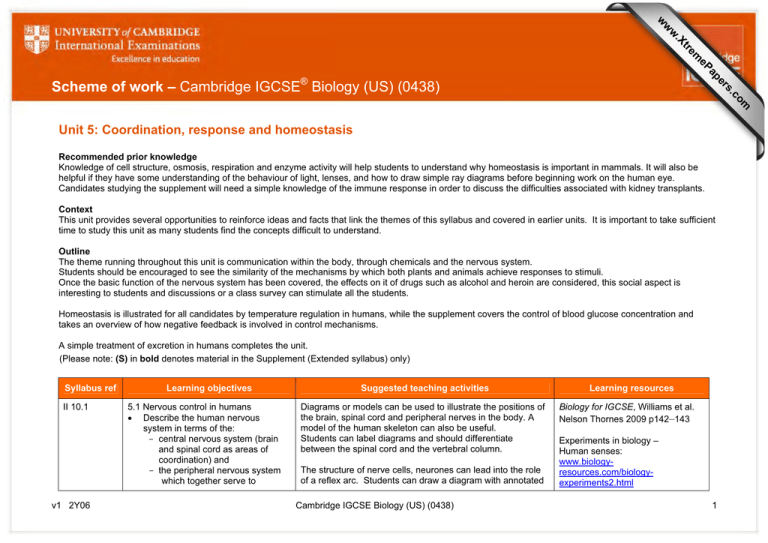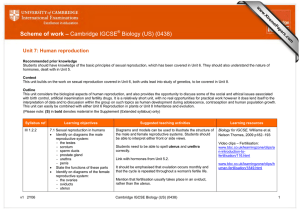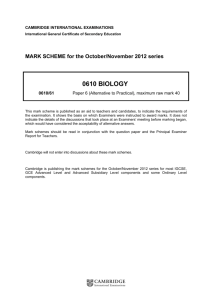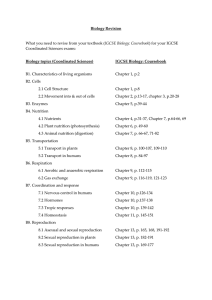Scheme of work – Cambridge IGCSE Biology (US) (0438)
advertisement

s er ap eP m e tr .X w w w om .c Scheme of work – Cambridge IGCSE® Biology (US) (0438) Unit 5: Coordination, response and homeostasis Recommended prior knowledge Knowledge of cell structure, osmosis, respiration and enzyme activity will help students to understand why homeostasis is important in mammals. It will also be helpful if they have some understanding of the behaviour of light, lenses, and how to draw simple ray diagrams before beginning work on the human eye. Candidates studying the supplement will need a simple knowledge of the immune response in order to discuss the difficulties associated with kidney transplants. Context This unit provides several opportunities to reinforce ideas and facts that link the themes of this syllabus and covered in earlier units. It is important to take sufficient time to study this unit as many students find the concepts difficult to understand. Outline The theme running throughout this unit is communication within the body, through chemicals and the nervous system. Students should be encouraged to see the similarity of the mechanisms by which both plants and animals achieve responses to stimuli. Once the basic function of the nervous system has been covered, the effects on it of drugs such as alcohol and heroin are considered, this social aspect is interesting to students and discussions or a class survey can stimulate all the students. Homeostasis is illustrated for all candidates by temperature regulation in humans, while the supplement covers the control of blood glucose concentration and takes an overview of how negative feedback is involved in control mechanisms. A simple treatment of excretion in humans completes the unit. (Please note: (S) in bold denotes material in the Supplement (Extended syllabus) only) Syllabus ref II 10.1 v1 2Y06 Learning objectives 5.1 Nervous control in humans • Describe the human nervous system in terms of the: - central nervous system (brain and spinal cord as areas of coordination) and - the peripheral nervous system which together serve to Suggested teaching activities Diagrams or models can be used to illustrate the positions of the brain, spinal cord and peripheral nerves in the body. A model of the human skeleton can also be useful. Students can label diagrams and should differentiate between the spinal cord and the vertebral column. The structure of nerve cells, neurones can lead into the role of a reflex arc. Students can draw a diagram with annotated Cambridge IGCSE Biology (US) (0438) Learning resources Biology for IGCSE, Williams et al. Nelson Thornes 2009 p142–143 Experiments in biology – Human senses: www.biologyresources.com/biologyexperiments2.html 1 Syllabus ref Learning objectives coordinate and regulate body functions • II 10.1 labels of a motor neurone. Identify: - motor (effector) - relay (connector) - sensory neurones from diagrams • Describe a simple reflex arc in terms of sensory, relay and motor neurones • Describe a reflex action as a means of automatically and rapidly integrating and coordinating stimuli with responses The reflex arc is important to many organisms for selfprotection. Students will understand its structure if different reflexes are considered: knee jerk, touching a pin with one finger. It is important to understand the role of the spinal cord in a reflex action and the receptor and effector. Students should understand that reflex actions are not learnt responses but automatic. State that muscles and glands can act as effectors This can be shown by the labels on the reflex arc as arm muscles contract and move away from the stimulus. Salivary glands that respond to food when is in the mouth. • Describe the action of antagonistic muscles to include the biceps and triceps at the elbow joint A simple experiment can show the action of the arm muscles. Students like to find out how strong they are by lifting different weights and to see the contraction of their biceps muscle. It is important to understand that muscles can contract and relax but cannot become shorter. Two muscles work together to move bones but they act antagonistically to produce the movement. The action of leg muscles and those in the oesophagus (Unit 2.5/2.6) can be discussed. Define sense organs as groups of receptor cells responding to specific stimuli: - light - sound - touch Learning resources Practical Biology – Human sensation and perception: www.nuffieldfoundation.org/practica l-biology/human-sensation-andperception Revision – The nervous system: www.lgfl.skoool.co.uk/content/keyst age4/biology/pc/lessons/uk_ks4_ne rvous_system/h-frame-ie.htm • • v1 2Y06 Suggested teaching activities Students should understand that there are different types of stimuli, chemical or mechanical, and that a sense organ combines receptors with other cells. Simple experiments can demonstrate the response of sense organs. A circus around the lab will allow all students to Cambridge IGCSE Biology (US) (0438) Biology for IGCSE, Williams et al. Nelson Thornes, 2009 p144–149 Practical Biology – Reflex actions: www.nuffieldfoundation.org/practica l-biology/reflex-nerves-andreactions This website has some ideas about reaction time: www.humanbenchmark.com/tests/r eactiontime/index.php Measuring reaction time: www.bbc.co.uk/science/humanbody /sleep/sheep/ Neuroscience for kids: www.faculty.washington.edu/chudle r/neurok.html Despite the title, some of the material at this site is a little advanced for IGCSE students. 2 Syllabus ref Learning objectives • Suggested teaching activities Learning resources - temperature - chemicals investigate each stimulus. Describe the structure and function of the eye including accommodation and pupil reflex The relation between the eye as a receptor and an effector in response to the stimulus of light can be used to reinforce the concept of a response to external stimuli. Biology for IGCSE, Williams et al. Nelson Thornes 2009 p150–151 A model of the eye can be used to illustrate the relevant structures. Revision – The eye: www.bbc.co.uk/schools/gcsebitesiz e/science/edexcel/electrical/thenerv oussystemrev4.shtml Extension – A cow or a sheep's eye can be dissected. A large round flask containing fluorescein with a convex lens at the front can be used to show how light is focussed on the retina (at the back of the flask). Students can be given a large unlabelled diagram of the eye. Laminated cards on which the 14 important labels are written can be used to actively label the eye diagram. The class can be divided into teams to ask questions about structure and function to aid learning and the understanding of the eye. Students can use small mirrors to draw their own eye(s). If the eyes are moved up and down and from side to side, the whites of the eyes are seen. Accommodation is shown by reading and then looking outside to a distant object. Close vision: Ciliary muscles Contract. www.scool.co.uk/gcse/biology/nervesand-hormones/revise-it/the-eye Student progress could be assessed using: May/June 2011 Paper 0610/21 question 4 Oct/Nov 2010 Paper 0610/22 question 3 May/June 2009 Paper 0610/02 question 7 May/June 2008 Paper 0610/02 question 10 Oct/Nov 2008 Paper 0610/02 question 8 II 10.1 (S) v1 2Y06 5.1 • Distinguish between voluntary and involuntary actions The pupil reflex is a good example of a reflex action in which the pupil controls the amount of light falling on the retina for its protection. Students can work in pairs and investigate the effect on the Cambridge IGCSE Biology (US) (0438) Revision – Reflex actions: www.bbc.co.uk/schools/gcsebitesiz e/science/aqa/human/thenervoussy stemrev3.shtml 3 Syllabus ref Learning objectives Suggested teaching activities Learning resources size of pupil of having the eyes closed for 10 seconds and then open. The effect of a torch shone into the eye and the change in pupil when looking at a near and then a distant object can all be investigated. Students can record their results and compare their reactions. Students should be able to suggest voluntary and involuntary responses. They should understand that a voluntary action involves the brain in its initiation, that it is a conscious thought to make an action. Involuntary actions are automatic and faster than voluntary actions. Refer to heart beat in Unit 4.6 and peristalsis in Unit 2.6. Student progress could be assessed using: May/June 2010 Paper 0610/32 question 1 • Distinguish between rods and cones in terms of: - function and - distribution. Revision – The eye: www.bbc.co.uk/schools/gcsebitesiz e/science/ocr_gateway/ourselves/3 _keeping_in_touch2.shtml Rods and cones are light-sensitive receptor cells in the retina. Cones for Colour in the fovea. Rods for light intensity throughout the retina. Extension – students could investigate colour perception and colour blindness. Possible link to genetics (Unit 8). Student progress could be assessed using: May/June 2010 Paper 0610/31 question 1 II 10.2 v1 2Y06 5.2 Hormones • Define a hormone as a chemical substance, produced by a gland, carried in the blood which alters the activity of one or more specific Use a simple diagram of the human body to show the source and the site of action of different hormones. Biology for IGCSE, Williams et al. Nelson Thornes, 2009 p152–153 Students will know about the sex hormones and can add adrenaline to their diagram. Cambridge IGCSE Biology (US) (0438) 4 Syllabus ref Learning objectives • • • target organs and is then destroyed by the liver State the role of the hormone adrenaline in the chemical control of metabolic activity, including increasing the blood glucose concentration and pulse rate Give examples of situations in which adrenaline secretion increases Compare nervous and hormonal control systems Suggested teaching activities Adrenaline makes a good introduction to hormones as most students can relate to its effects. It should be mentioned that adrenaline bridges the gap between nervous and hormonal control because of its fast and short lived action. Students can discuss the effects on the body of the flight and fight hormone with their own examples. Learning resources Hormones and their effects: www.abpischools.org.uk/page/mod ules/hormones/index.cfm Revision – Hormones: www.bbc.co.uk/schools/gcsebitesiz e/science/edexcel/electrical/hormon esrev2.shtml Students may produce their own table of comparison with sub-titles of: form and pathway of transmission speed of transmission duration of effect of hormone response to hormone Student progress could be assessed using: Oct/Nov 2008 Paper 0610/02 question 8c II 10.2 (S) 5.2 • Discuss the use of hormones in food production The meat and cattle industries have used hormones for many years. The sex hormones are used to promote growth in calves and lambs but not in poultry. Synthetic growth promoters can make animals grow faster. The European Union, Japan, Canada, Australia banned the use of hormones in cattle in 1981 but the US still uses protein and steroid hormones for cattle growth and to increase their milk yield. Posilac – An introduction: www.monsanto.com/newsviews/Pa ges/milk-labeling.aspx A view from the firm that makes and sells BST Students should be able to discuss the use of hormones in food production using information from journals, newspaper articles and the web. II 10.3 v1 2Y06 5.3 Tropic responses • Define and investigate: - geotropism as a response in which a plant grows towards or away from gravity, and - phototropism as a response in Plants are able to respond to certain stimuli. Students can now study plant response to light and water. Geotropism and phototropism should be investigated with simple experiments using seeds that have been germinated before the start of the topic. It should be made clear that these are plant growth responses, auxin, a plant hormone, is Cambridge IGCSE Biology (US) (0438) Biology for IGCSE, Williams et al. Nelson Thornes, 2009 p154–155 5 Syllabus ref Learning objectives which a plant grows towards or away from the direction from which light is coming Suggested teaching activities produced by the shoot and root tips of the growing plant. The direction of growth is related to the direction of the stimulus. Revision: www.www.bbc.co.uk/schools/gcsebitesize/science/add_gate way/living/controlplantgrowthrev1.shtml Extension – practical work using auxins and rooting compounds. Student progress could be assessed using: May/June 2010 Paper 0610/21 question 9 (S) 5.3 • Explain the chemical control of plant growth by auxins including geotropism and phototropism in terms of auxins regulating differential growth, and the effects of synthetic plant hormones used as weedkillers Plant hormones are used to make fruit develop at the same time to allow for efficient picking. Weeds in fields of monoculture such as wheat are killed by selective weedkillers. Hormones can inhibit the fertilisation of fruit such as grapes that are then seedless. The students could discuss the advantages and disadvantages of human manipulation of plant development. Extension – effects of weedkillers on seedlings. Extension – effects of IAA on mustard seedlings. Learning resources Experiments in biology: Germination and Tropisms www.biologyresources.com/biologyexperiments2.html The response of seedlings to light: www.saps.org.uk/secondary/teachi ng-resources/185-student-sheet-8the-response-of-seedlings-to-light Investigating geotropism: www.saps.org.uk/secondary/teachi ng-resources/184-student-sheet-7the-behaviour-of-hypocotyls Practical Biology – Plant responses to stimuli: www.nuffieldfoundation.org/practica l-biologyinterpreting-investigationplant-hormones Investigating plant growth regulators: www.saps.org.uk/secondary/teachi ng-resources/183-student-sheet-6investigating-plant-growthregulators An experiment involving the use of IAA on mustard seedlings: www.saps.org.uk/secondary/teachi ng-resources/111-investigating-theeffects-of-iaa-on-root-growth-inmustard-seedlings II 10.4 v1 2Y06 5.4 Homeostasis The students should appreciate the importance of Cambridge IGCSE Biology (US) (0438) Biology for IGCSE, Williams et al. 6 Syllabus ref Learning objectives • • • • • Define homeostasis as the maintenance of a constant internal environment Identify, on a diagram of the skin: - hairs - sweat glands - temperature receptors - blood vessels - fatty tissue Describe the maintenance of a constant body temperature in humans in terms of insulation and the role of temperature receptors in the skin: - sweating - shivering - vasodilation - vasoconstriction of arteries supplying skin surface capillaries and the coordinating role of the brain Suggested teaching activities maintaining an internal steady state to keep the conditions in the tissue fluid around the cells constant. The concepts of diffusion, osmosis, enzyme activity and respiration will guide the students to understand the importance of constant pH, oxygen and carbon dioxide concentrations, water, enzymes and hormones. Students could think how they feel when they have a high fever to discuss the importance of an internal steady state. Body temperature is related to homeostasis in which communication is through the nervous system. Students should understand that the blood capillaries do not move up and down in the skin during vasodilation and vasoconstriction respectively. Emphasise the cooling effect sweating due to the evaporation of water. The brain receives impulses from sensory receptors and responds by adjusting the condition to maintain an optimum. A clear example linked to the skin is temperature control. Extension – students could research hypothermia and heat stroke. Learning resources Nelson Thornes, 2009 p130–133 PowerPoint presentation – Homeostasis: www.biologyresources.com/biology-CD.html Practical Biology – Sweating: www.nuffieldfoundation.org/practica l-biology/interpreting-informationabout-sweating-and-temperature Skin – structure and function: www.abpischools.org.uk/page/mod ules/skin/index.cfm A website to show penguin huddling: www.coolantarctica.com/Antarctica %20fact%20file/science/cold_peng uins.htm Student progress could be assessed using: May/June 2011 Paper 0610/32 question 2 May/June 2011 Paper 0610/22 question 3 May/June 2010 Paper 0610/22 question 7 II 10.4 (S) v1 2Y06 5.4 • Explain the concept of control by negative feedback • Describe the control of: - the glucose content of the blood by the liver - insulin and glucagon from the pancreas The control of temperature and glucose can illustrate negative feedback. Control of blood sugar: www.abpischools.org.uk/page/mod ules/diabetes/index.cfm Flow diagrams can show how this is achieved. The control of glucose content can be linked with diabetes, a relatively common disorder in many countries. The students should consider why it is important to control blood glucose content, thinking back to what they know about diet, including sweet fizzy drinks, osmosis and respiration. Correct spelling is essential to distinguish between glycogen Cambridge IGCSE Biology (US) (0438) 7 Syllabus ref Learning objectives Suggested teaching activities Learning resources and glucagon. Student progress could be assessed using: May/June 2009 Paper 0610/31 question 2c Oct/Nov 2010 Paper 0610/33 question 2 II 10.5 5.5 Drugs • Define a drug as any substance taken into the body that modifies or affects chemical reactions in the body • Describe the medicinal use of antibiotics for the treatment of bacterial infection • Describe the effects of the abuse of heroin: - a powerful depressant - problems of addiction - severe withdrawal symptoms - associated problems such as crime and infection e.g. HIV/AIDS • • v1 2Y06 Describe the effects of excessive consumption of alcohol: - reduced self-control - depressant - effect on reaction times - damage to the liver - social implications This topic lends itself to class discussion or group presentations. Students will understand that accepted drugs are used to relieve pain and to treat a disease or infection. Antibiotics are drugs that either disrupt the metabolic processes of growth of the bacterium or stop the growth of bacterial spores. The students should be allowed to discuss the implications of taking recreational drugs both socially and medically including their effect on the nervous system and their possible long-term effects. Students need to understand the effects, the symptoms and possible problems with taking heroin. Many recreational drugs can become addictive such as cigarette smoking and alcohol. Cigarette smoking can be linked with Unit 4.4. Student progress could be assessed using: May/June 2010 Paper 0610/22 question 5 Oct/Nov 2008 Paper 0610/02 question 2 Describe the effects of tobacco smoke and its major toxic components: - tar - nicotine - carbon monoxide - smoke particles on the gas exchange system Biology for IGCSE, Williams et al. Nelson Thornes, 2009 p158–165 Practical Biology – Smoking: www.nuffieldfoundation.org/practica l-biology/going-smoke Teacher resource: Drug scenes complied by:Royal College of Psychiatrists. Drug Abuse published by Independence Educational Publishers Drug information: www.talktofrank.com/ Drug abuse: www.abpischools.org.uk/res/coRes ourceImport/resources04/drugs/ind ex.cfm Revision – Smoking: www.lgfl.skoool.co.uk/content/keyst age4/biology/pc/modules/breathing _respiration/smoking/index.html Cambridge IGCSE Biology (US) (0438) 8 Syllabus ref Learning objectives Suggested teaching activities II 10.5 (S) 5.5 • Explain why antibiotics kill bacteria but not viruses Viruses do not have their own metabolism but use the pathways of their host cell which prevents them from being destroyed by antibiotics. II 9 5.6 Excretion in humans • Define excretion as the removal from organisms of toxic materials, the waste products of metabolism (chemical reactions in cells including respiration) and substances in excess of requirements • Substances should include: - carbon dioxide - urea - salts • Describe the function of the kidney in terms of the removal of urea and excess water and the reabsorption of glucose and some salts (details of kidney structure and nephron are not required) • State the relative positions of: - ureters - bladder - urethra in the body • State that urea is formed in the liver from excess amino acids • State that: - alcohol - drugs - hormones are broken down in the liver Excretion can be considered as another way in which the environment of cells is controlled, by removing toxic materials, waste products of metabolism and substances in excess of requirements. Ensure that they understand the difference between egestion (the removal of substances from the alimentary canal, that have never been part of the body at all) and excretion. Only a simple understanding of the formation of urea from excess amino acids is required. 5.6 • Outline the structure of a kidney: - cortex - medulla This should be dealt with very simply as even students studying the supplement may find details of nephron structure and the role of the kidney in reabsorption of glucose, salts and water difficult. II 9 (S) v1 2Y06 Learning resources Biology for IGCSE, Williams et al. Nelson Thornes, 2009 p134–135 Kidneys: www.abpischools.org.uk/res/coRes ourceImport/resources04/kidneys/in dex.cfm It is important to differentiate between ureter and urethra. Labelled diagrams will help the students to understand the structure of the kidney. Refer to Unit 7.1 for male reproductive system. Extension – A kidney from a sheep or a pig can be dissected to show the gross structure. Mention that hormones are also broken down by the liver. Student progress could be assessed using: May/June 2009 Paper 0610/02 question 2 Oct/Nov 2010 Paper 0610/21 question 9 May/June 2008 Paper 0610/02 question 11 Cambridge IGCSE Biology (US) (0438) Biology for IGCSE, Williams et al. Nelson Thornes, 2009 p136–139 9 Syllabus ref Learning objectives • • • • • v1 2Y06 - the start of the ureter Outline the structure and functioning of a kidney tubule, including role of renal capsule in filtration from blood of: - water - glucose - urea - salts Role of tubule in reabsorption: - of glucose - most of the water - some of the salts back into blood leading to concentration of urea in the urine as well as loss of excess water and salts Explain dialysis in terms of maintenance of glucose and protein concentration in blood and diffusion of urea from blood dialysis fluid Discuss the application of dialysis in kidney machines Discuss the advantages and disadvantages of kidney transplants, compared with dialysis Suggested teaching activities The structure of the kidney can lead into the use of dialysis and the machine's role in removing excess urea and water. The importance of homeostasis can be reinforced at this point as the kidneys are osmoregulators. Learning resources Kidneys: www.abpischools.org.uk/res/coRes ourceImport/resources04/kidneys/in dex.cfm The importance of retaining glucose must be emphasised and it is excess water, urea and salts that are excreted in urine. This will link back to Unit 5.4 which considers diabetes. Diagams of dialysis machines should be studied to enable students to understand the process and the role of the dialysis fluid. Students will need to remember what they know about osmosis and diffusion in order to understand how dialysis works. There is a link between the immune system and tissue rejection, when considering kidney transplants. Extension – Dissection of a kidney and teasing out of nephrons from the cortex tissue under a microscope. Revision – Kidney failure: www.scool.co.uk/gcse/biology/homeostasi s/revise-it/dealing-with-kidneyfailure Student progress could be assessed using: May/June 2011 Paper 0610/31 question 4 Oct/Nov 2010 Paper 0610/32 question 2 Oct/Nov 2009 Paper 0610/31 question 4 May/June 2008 Paper 0610/31 question 5 Cambridge IGCSE Biology (US) (0438) 10





